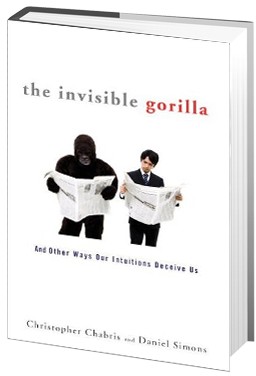These and much more are grist for Christopher Chabris and Daniel Simons’ new book, The Invisible Gorilla, an exploration of the distortions and outright illusions that accompany our individual and collective perceptions and memories. Don’t be fooled, note the authors: our brains are not cameras—they construct and reconstruct memories and perceptions with creative aplomb—sometimes they addeth; other times they taketh away.
If the shoe won’t fit . . . Reading the New York Times’ thumbs-up review of the book several Sundays ago ignited my own memory of perhaps the greatest collective illusion of the Cold War era. Remember footage or photos of Khrushchev banging his shoe during his 1960 speech at the United Nations? Nikita with shoe is one of the iconic images of the era. But according to former Washington Post journalist Peter Carlson in his entertaining K Blows Top, there was no video and no photo of the “act.” Alas, we’ve inherited just one photo of the shoe—a loafer, which sits inertly on the desk in front of K.
Khrushchev’s son, Sergei, who has lived in the United States since 1991, notes Carlson, regularly asks audiences if they recall images of his father banging the shoe. “I say, please raise your hand if you saw it, and many people raise their hands. They really think they saw it,” he remarks in Carlson’s book. Try your own version of the question at your next party. Some of your friends will bet the house that they saw K’s shoe in action. Their certainty will reflect the viral potency and reinforcement of the human herd's collective memories.
Two weeks ago, I became excessively agitated upon discovering the Web photo (above right) of Khrushchev in the act—so agitated that I emailed Khrushchev’s biographer, William Taubman, at Amherst College. The professor’s response was decisive:
I'm certain it's been photoshopped. Because even if he did bang his shoe (which I doubt), he is alleged to have done so while seated at a desk rather than standing at the lectern. But after interviewing a lot of people about the whole episode (many of them after my K bio came out), I believe K only brandished his shoe but did not bang it.
Learn how Professor Taubman arrived at his conclusions in his sparkling, meticulous opinion essay in the July 26-27 issue of the International Herald Tribune here.
A Note to Self-Important Photoshoppers. Be advised that Photoshopping a loafer into K’s hand and launching the photo into cyberspace may reflect your affinity for a consummate Stalinist tradition. Prominent party members among Stalin's millions of purged victims regularly got the air brush in official photographs. Consider the before-and-after frames below of Nikolai Yezhov, head of the NKVD (forerunner of the KGB), who was purged in 1939 and executed in 1940. The photos are highlights in the Newseum’s intriguing Web exhibit, The Commissar Vanishes. Visit it here.
And take it from Chabris and Simons—getting a handle on perception and memory can be a tall order unto itself. Additional “noise” is not required. Please hold the Photoshop!
Subscribe to Wig & Pen.







1 comment:
All I can say is. YIKES!
Post a Comment